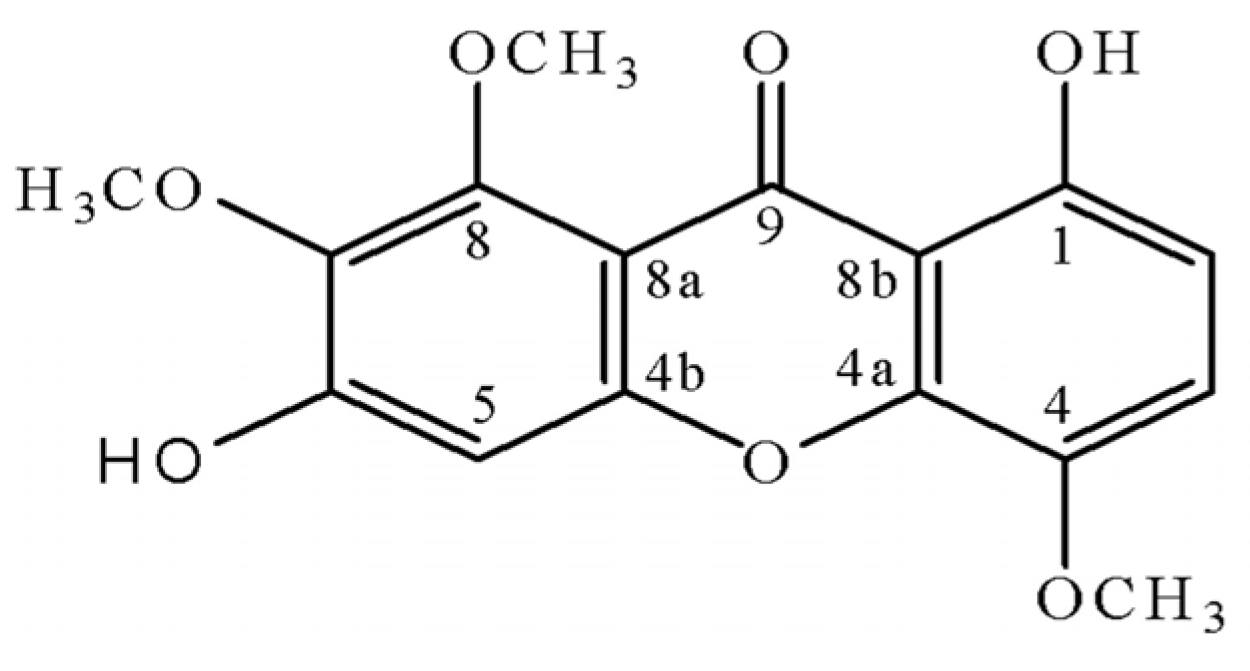A New Xanthone from Moutabea guianensis Aubl
Abstract
:1. Introduction

2. Results and Discussion
| Positions | δH ( J in Hz) | δC | DEPT | HMBC (H→C) | |
|---|---|---|---|---|---|
| 1 | - | 154.9 | C | ||
| 2 | 6.68 (d, 9.0) | 108.9 | CH | 8b, 1, 4 | |
| 3 | 7.18 (d, 9.0) | 119.8 | CH | 1, 4a, 4 | |
| 4 | - | 139.4 | C | ||
| 4a | - | 145.1 | C | ||
| 4b | - | 154.5 | C | ||
| 5 | 6.90 (s) | 99.3 | CH | 8a, 9, 4b, 6, 7 | |
| 6 | - | 155.9 | C | ||
| 7 | - | 137.6 | C | ||
| 8 | - | 152.2 | C | ||
| 8a | - | 109.3 | C | ||
| 8b | - | 109.3 | C | ||
| 9 | - | 181.3 | C | ||
| 4-OCH3 | 3.93 (s) | 57.5 | CH3 | 4 | |
| 7-OCH3 | 4.02 (s) | 61.7 | CH3 | 7 | |
| 8-OCH3 | 4.00 (s) | 61.9 | CH3 | 8 | |
| 1-OH | 12.52 (s) | - | - | 2, 1, 8b |
3. Experimental
3.1. General Information
3.2. Plant Material
3.3. Extraction and Isolation
4. Conclusions
Supplementary Materials
Acknowledgments
Author Contributions
Acknowledgments
Conflicts of Interest
References
- Klein Junior, L.C.; Gandolfi, R.B.; Santin, J.R.; Lemos, M.; Cechinel Filho, V.; Andrade, S.F. Antiulcerogenic activity of extract, fractions, and some compounds obtained from Polygala cyparissias St. Hillaire e Mouquin (Polygalaceae). N.-S. Arch. Pharmacol. 2010, 381, 121–126. [Google Scholar] [CrossRef]
- Yang, X.; Xu, L.; Yang, S. Xanthones from the stems of Securidaca inappendiculata. Phytochemistry 2001, 58, 1245–1249. [Google Scholar] [CrossRef]
- Bergeron, C.; Marston, A.; Wolfender, J.L.; Mavi, S.; Rogers, C.; Hostettmann, K. Isolation of polyphenols from Polygala gazensis and liquid chromatography-mass spectrometry of related African Polygala species. Phytochem. Anal. 1997, 8, 32–36. [Google Scholar]
- Pinheiro, T.R.; Cechinel, V.; Santos, A.R.S.; Calixto, J.B.; Delle-Monache, F.; Pizzolatti, M.G.; Yunes, R.A. Three xanthones from Polygala cyparissias. Phytochemistry 1998, 48, 725–728. [Google Scholar] [CrossRef]
- Pizzolatti, M.G.; Cunha, A., Jr.; Pereira, W.S.; Delle Monache, F.A. A new styryl-2-pyrone derivative from Polygala sabulosa (Polygalaceae). Biochem. Syst. Ecol. 2004, 32, 603–606. [Google Scholar]
- Rocha, J.L.C.; Pastore, J.F.B.; Brandão, H.N.; Azevedo, A.; Devid, J.P.; Santos, E.O.; David, J.M. Quantificação de salicilato de metila em quatro gêneros de Polygalaceae, POR CLAE-DAD. Quim. Nova 2012, 35, 2263–2266. [Google Scholar] [CrossRef]
- Capra, J.C.; Cunha, M.P.; Machado, D.G.; Zomkowski, A.D.E.; Mendes, B.G.; Santos, A.R.S.; Pizzolatti, M.G.; Rodrigues, A.L.S. Antidepressant-like effect of scopoletin, a coumarin isolated from Polygala sabulosa (Polygalaceae) in mice: Evidence for the involvement of monoaminergic systems. Eur. J. Pharmacol. 2010, 643, 232–238. [Google Scholar] [CrossRef]
- Lepore, L.; Malafronte, N.; Condero, F.B.; Gualtieri, M.J.; Abdo, S.; Piaz, F.D.; Tommasi, N.D. Isolation and structural characterization of glycosides from an anti-angiogenic extract of Monnina obtusifolia H.B.K. Fitoterapia 2007, 82, 178–183. [Google Scholar]
- Ripardo Filho, H.S.; Pacheco, L.C.; Souza Filho, A.P.S.; Guilhon, G.M.S.P.; Arruda, M.S.P.; Santos, L.S. Bioensaios de atividade alelopática dos esteroides espinasterol, espinasterona e glicopiranosil espinasterol. Planta Daninha 2012, 30, 705–712. [Google Scholar]
- Van der Sluis, W.G.; Labadie, R.P. Polyoxygenated xanthones of Centaurium littorale. Phytochemistry 1985, 24, 2601–2605. [Google Scholar] [CrossRef]
- Sample Availability: Samples of the compound 1 are available from the authors.
© 2014 by the authors. Licensee MDPI, Basel, Switzerland. This article is an open access article distributed under the terms and conditions of the Creative Commons Attribution license ( http://creativecommons.org/licenses/by/4.0/).
Share and Cite
Da S. Ripardo Filho, H.; Pacheco, L.C.; Da S. Andrade, E.; Correa, M.J.C.; Guilhon, G.M.S.P.; Santos, L.S. A New Xanthone from Moutabea guianensis Aubl. Molecules 2014, 19, 8885-8889. https://doi.org/10.3390/molecules19078885
Da S. Ripardo Filho H, Pacheco LC, Da S. Andrade E, Correa MJC, Guilhon GMSP, Santos LS. A New Xanthone from Moutabea guianensis Aubl. Molecules. 2014; 19(7):8885-8889. https://doi.org/10.3390/molecules19078885
Chicago/Turabian StyleDa S. Ripardo Filho, Haroldo, Luidi C. Pacheco, Edinaldo Da S. Andrade, Marivaldo José C. Correa, Gisele Maria S. P. Guilhon, and Lourivaldo S. Santos. 2014. "A New Xanthone from Moutabea guianensis Aubl" Molecules 19, no. 7: 8885-8889. https://doi.org/10.3390/molecules19078885
APA StyleDa S. Ripardo Filho, H., Pacheco, L. C., Da S. Andrade, E., Correa, M. J. C., Guilhon, G. M. S. P., & Santos, L. S. (2014). A New Xanthone from Moutabea guianensis Aubl. Molecules, 19(7), 8885-8889. https://doi.org/10.3390/molecules19078885




